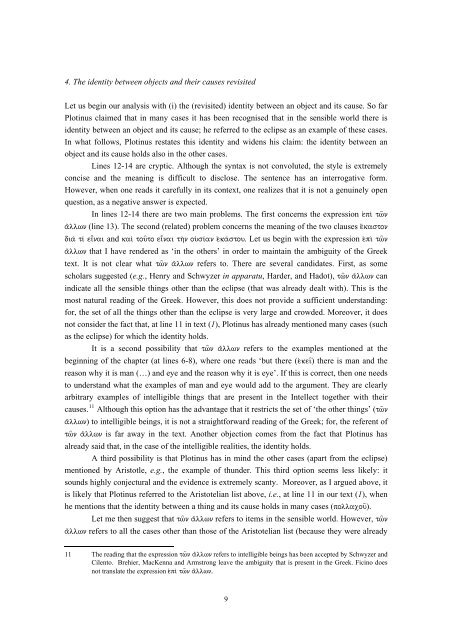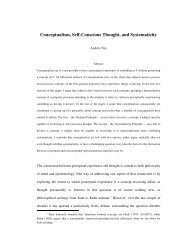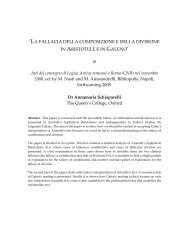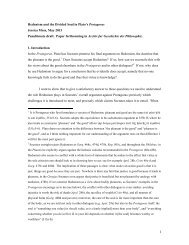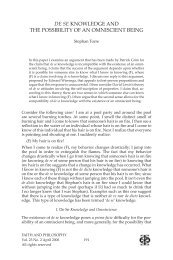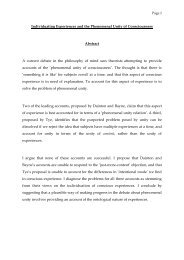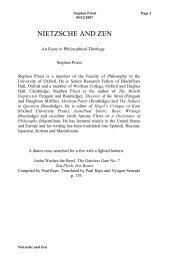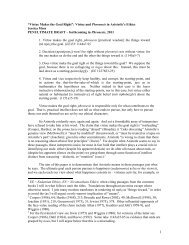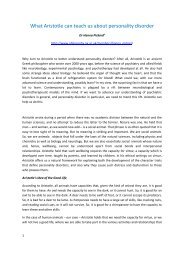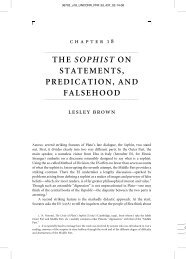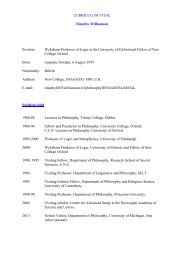Essence and Cause in Plotinus
Essence and Cause in Plotinus
Essence and Cause in Plotinus
You also want an ePaper? Increase the reach of your titles
YUMPU automatically turns print PDFs into web optimized ePapers that Google loves.
4. The identity between objects <strong>and</strong> their causes revisited<br />
Let us beg<strong>in</strong> our analysis with (i) the (revisited) identity between an object <strong>and</strong> its cause. So far<br />
Plot<strong>in</strong>us claimed that <strong>in</strong> many cases it has been recognised that <strong>in</strong> the sensible world there is<br />
identity between an object <strong>and</strong> its cause; he referred to the eclipse as an example of these cases.<br />
In what follows, Plot<strong>in</strong>us restates this identity <strong>and</strong> widens his claim: the identity between an<br />
object <strong>and</strong> its cause holds also <strong>in</strong> the other cases.<br />
L<strong>in</strong>es 12-14 are cryptic. Although the syntax is not convoluted, the style is extremely<br />
concise <strong>and</strong> the mean<strong>in</strong>g is difficult to disclose. The sentence has an <strong>in</strong>terrogative form.<br />
However, when one reads it carefully <strong>in</strong> its context, one realizes that it is not a genu<strong>in</strong>ely open<br />
question, as a negative answer is expected.<br />
In l<strong>in</strong>es 12-14 there are two ma<strong>in</strong> problems. The first concerns the expression e)piì tw½n<br />
aÃllwn (l<strong>in</strong>e 13). The second (related) problem concerns the mean<strong>in</strong>g of the two clauses eÀkaston<br />
dia\ ti¿ eiånai <strong>and</strong> kaiì tou=to eiånai th\n ou)si¿an e(ka/stou. Let us beg<strong>in</strong> with the expression e)piì tw½n<br />
aÃllwn that I have rendered as ‘<strong>in</strong> the others’ <strong>in</strong> order to ma<strong>in</strong>ta<strong>in</strong> the ambiguity of the Greek<br />
text. It is not clear what tw½n aÃllwn refers to. There are several c<strong>and</strong>idates. First, as some<br />
scholars suggested (e.g., Henry <strong>and</strong> Schwyzer <strong>in</strong> apparatu, Harder, <strong>and</strong> Hadot), tw½n aÃllwn can<br />
<strong>in</strong>dicate all the sensible th<strong>in</strong>gs other than the eclipse (that was already dealt with). This is the<br />
most natural read<strong>in</strong>g of the Greek. However, this does not provide a sufficient underst<strong>and</strong><strong>in</strong>g:<br />
for, the set of all the th<strong>in</strong>gs other than the eclipse is very large <strong>and</strong> crowded. Moreover, it does<br />
not consider the fact that, at l<strong>in</strong>e 11 <strong>in</strong> text (1), Plot<strong>in</strong>us has already mentioned many cases (such<br />
as the eclipse) for which the identity holds.<br />
It is a second possibility that tw½n aÃllwn refers to the examples mentioned at the<br />
beg<strong>in</strong>n<strong>in</strong>g of the chapter (at l<strong>in</strong>es 6-8), where one reads ‘but there (e)keiÍ) there is man <strong>and</strong> the<br />
reason why it is man (…) <strong>and</strong> eye <strong>and</strong> the reason why it is eye’. If this is correct, then one needs<br />
to underst<strong>and</strong> what the examples of man <strong>and</strong> eye would add to the argument. They are clearly<br />
arbitrary examples of <strong>in</strong>telligible th<strong>in</strong>gs that are present <strong>in</strong> the Intellect together with their<br />
causes. 11 Although this option has the advantage that it restricts the set of ‘the other th<strong>in</strong>gs’ (tw½n<br />
aÃllwn) to <strong>in</strong>telligible be<strong>in</strong>gs, it is not a straightforward read<strong>in</strong>g of the Greek; for, the referent of<br />
tw½n aÃllwn is far away <strong>in</strong> the text. Another objection comes from the fact that Plot<strong>in</strong>us has<br />
already said that, <strong>in</strong> the case of the <strong>in</strong>telligible realities, the identity holds.<br />
A third possibility is that Plot<strong>in</strong>us has <strong>in</strong> m<strong>in</strong>d the other cases (apart from the eclipse)<br />
mentioned by Aristotle, e.g., the example of thunder. This third option seems less likely: it<br />
sounds highly conjectural <strong>and</strong> the evidence is extremely scanty. Moreover, as I argued above, it<br />
is likely that Plot<strong>in</strong>us referred to the Aristotelian list above, i.e., at l<strong>in</strong>e 11 <strong>in</strong> our text (1), when<br />
he mentions that the identity between a th<strong>in</strong>g <strong>and</strong> its cause holds <strong>in</strong> many cases (pollaxou=).<br />
Let me then suggest that tw½n aÃllwn refers to items <strong>in</strong> the sensible world. However, tw½n<br />
aÃllwn refers to all the cases other than those of the Aristotelian list (because they were already<br />
11 The read<strong>in</strong>g that the expression tw½n aÃllwn refers to <strong>in</strong>telligible be<strong>in</strong>gs has been accepted by Schwyzer <strong>and</strong><br />
Cilento. Brehier, MacKenna <strong>and</strong> Armstrong leave the ambiguity that is present <strong>in</strong> the Greek. Fic<strong>in</strong>o does<br />
not translate the expression e)piì tw½n aÃllwn.<br />
9


